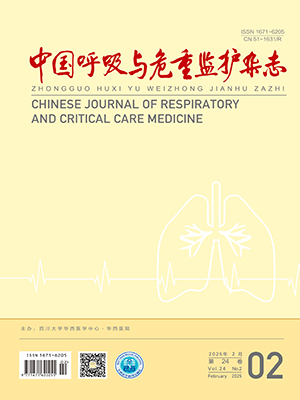| 1. |
GBD 2015 Chronic Respiratory Disease Collaborators. Global, regional, and national deaths, prevalence, disability-adjusted life years, and years lived with disability for chronic obstructive pulmonary disease and asthma, 1990-2015: a systematic analysis for the Global Burden of Disease Study 2015. Lancet Respir Med, 2017, 5(9): 691-706.
|
| 2. |
Adeloye D, Chua S, Lee C, et al. Global Health Epidemiology Reference Group (GHERG). Global and regional estimates of COPD prevalence: systematic review and meta-analysis. J Glob Health, 2015, 5(2): 020415.
|
| 3. |
Wang C, Xu J, Yang L, et al. China Pulmonary Health Study Group. Prevalence and risk factors of chronic obstructive pulmonary disease in China (the China Pulmonary Health [CPH] study): a national cross-sectional study. Lancet, 2018, 391(10131): 1706-1717.
|
| 4. |
Gan WQ, Man SF, Senthilselvan A, et al. Association between chronic obstructive pulmonary disease and systemic inflammation: a systematic review and a meta-analysis. Thorax, 2004, 59(7): 574-580.
|
| 5. |
Sin DD, Man SF. Why are patients with chronic obstructive pulmonary disease at increased risk of cardiovascular diseases? The potential role of systemic inflammation in chronic obstructive pulmonary disease. Circulation, 2003, 107(11): 1514-1519.
|
| 6. |
Iwamoto H, Yokoyama A, Kitahara Y, et al. Airflow limitation in smokers is associated with subclinical atherosclerosis. Am J Respir Crit Care Med, 2009, 179(1): 35-40.
|
| 7. |
Paek YJ, Jung KS, Hwang YI, et al. Association between low pulmonary function and metabolic risk factors in Korean adults: the Korean National Health and Nutrition Survey. Metabolism, 2010, 59(9): 1300-1306.
|
| 8. |
Sonoda N, Morimoto A, Tatsumi Y, et al. prospective study of the impact of diabetes mellitus on restrictive and obstructive lung function impairment: the Saku study. Metabolism, 2018, 82: 58-64.
|
| 9. |
Yamashina A, Tomiyama H, Takeda K, et al. Validity, reproducibility, and clinical significance of noninvasive brachial-ankle pulse wave velocity measurement. Hypertens Res, 2002, 25(3): 359-364.
|
| 10. |
Vlachopoulos C, Aznaouridis K, Terentes-Printzios D, et al. Prediction of cardiovascular events and all-cause mortality with brachial-ankle elasticity index: a systematic review and meta-analysis. Hypertension, 2012, 60(2): 556-562.
|
| 11. |
Miller MR, Hankinson J, Brusasco V, et al. Standardisation of spirometry. Eur Respir J, 2005, 26(2): 319-338.
|
| 12. |
胡大一. 心血管疾病防治指南和共识 2008. 北京: 人民卫生出版社, 2008.
|
| 13. |
Bolton CE, Cockcroft JR, Sabit R, et al. Lung function in mid-life compared with later life is a stronger predictor of arterial stiffness in men: the Caerphilly Prospective Study. Int J Epidemiol, 2009, 38(3): 867-876.
|
| 14. |
Duprez DA, Hearst MO, Lutsey PL, et al. Associations among lung function, arterial elasticity, and circulating endothelial and inflammation markers: the multiethnic study of atherosclerosis. Hypertension, 2013, 61(2): 542-548.
|
| 15. |
Oda M, Omori H, Onoue A, et al. Association between airflow limitation severity and arterial stiffness as determined by the brachial-ankle pulse wave velocity: across-sectional study. Intern Med, 2015, 54(20): 2569-2575.
|
| 16. |
Inomoto A, Fukuda R, Deguchi J, et al. Relation between respiratory function and arterial stiffness assessed using brachial-ankle pulse wave velocity in healthy workers. J Phys Ther Sci, 2017, 29(9): 1664-1669.
|
| 17. |
Chen R, He W, Zhang K, et al. Airflow obstruction was associated with elevation of brachial-ankle pulse wave velocity but not ankle-brachial index in aged patients with chronic obstructive pulmonary disease. Atherosclerosis, 2015, 242(1): 135-140.
|
| 18. |
Cinarka H, Kayhan S, Gumus A, et al. Arterial stiffness measured via carotid femoral pulse wave velocity is associated with disease severity in COPD. Respir Care, 2014, 59(2): 274-280.
|
| 19. |
Jacobs DR Jr, Yatsuya H, Hearst MO, et al. Rate of decline of forced vital capacity predicts future arterial hypertension: the Coronary Artery Risk Development in Young Adults Study. Hypertension, 2012, 59(2): 219-225.
|
| 20. |
Sabit R, Bolton CE, Edwards PH, et al. Arterial stiffness and osteoporosis in chronic obstructive pulmonary disease. Am J Respir Crit Care Med, 2007, 175(12): 1259-1265.
|
| 21. |
Zieman SJ, Melenovsky V, Kass DA. Mechanisms, pathophysiology, and therapy of arterial stiffness. Arterioscler Thromb Vasc Biol, 2005, 25(5): 932-943.
|
| 22. |
Shifren A, Mecham RP. The stumbling block in lung repair of emphysema elastic fiber assembly. Proc Am Thorac Soc, 2006, 3(5): 428-433.
|
| 23. |
Lang MR, Fiaux GW, Gillooly M, et al. Collagen content of alveolar wall tissue in emphysematous and non-emphysematous lungs. Thorax, 1994, 49(4): 319-326.
|
| 24. |
Yasmin, Mceniery CM, O'Shaughnessy KM, et al. Variation in the human matrix metalloproteinase-9 gene is associated with arterial stiffness in healthy individuals. Arterioscler Thromb Vasc Biol, 2006, 26(8): 1799-1805.
|
| 25. |
Mao JT, Tashkin DP, Belloni PN, et al. All-trans retinoic acid modulates the balance of matrix metalloproteinase-9 and tissue inhibitor of metalloproteinase-1 in patients with emphysema. Chest, 2003, 124(5): 1724-1732.
|
| 26. |
Higashimoto Y, Yamagata Y, Iwata T, et al. Increased serum concentrations of tissue inhibitor of metalloproteinase-1 in COPD patients. Eur Respir J, 2005, 25(5): 885-890.
|




